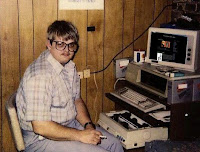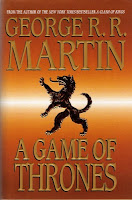Today’s post has to do with a bit of techy stuff. I’m sure many of you already do these sorts of things, but it’s always worth reminding folks just in case.
First order of business! All you Live Journalers click on the picture and go read that article. Seems the evil hackers are hacking LJ accounts and spreading their evilness everywhere.
It used to be that one of the most dreaded things about a fire (aside from the potential loss of life) was the chance of losing all those memories. Picture albums gone up in a blaze, old keepsakes melted down to slag. And so we all take precautions from fire alarms to fire safes. Even if we didn’t go so far as to lock things away in safes, we still had the odds on our side. I mean, how many people do you know who have had their house burn down?

But then one day technology snuck into our lives and it now seems that we can’t live them without it. Financial data, digital photos, music collections, movies, and most important of all with respects to writers, our stories, are all stored on our trusty computers in a lovely digital format that will stand the test of time. The trouble is, hell has loosed its minions in the form of angry little computer demons who write viruses and trojans and worms “oh my.” And in the blink of an eye all that work, all of those hours, days, weeks, months and years of tireless writing and hair pulling are all gone without even a few charred remains to cry over.
Unfortunately, this is not one of those things that we can assume “will never happen to me.” As one of my writing group partners can attest, we can all get struck by a virus, and the odds are that eventually we will. When it hit her it wiped out everything. That’s right, imagine your ‘Documents’ folder gone. Imagine it all being gone. It was enough to scare the begezus out of me. So I set about beefing up security and the like and thought of a few things to share.
Immune System: Make sure you have a good anti-virus software on your computer. I used to mess around with trying to find good free alternatives until one day I realized that losing what was on my hard-drive was far more expensive than saving a few bucks on a software subscription.
First, I got McCaffee and for a year I was very happy with it until they upgraded to another version, a version that I was able to track back to my system slowing to a crawl because of it’s resource demands. And I really did track it back to McCaffee because I found two other people that had the same problems occur after the new version went up. They also both saw them go away after they shut McCaffee off at my request. I got my money back and did some research for a new program that ended up being Kaspersky.
Kaspersky, too, I had for a year. It came highly recommended by the reviews I had read, and I was quite happy with it until I got my new laptop which came with a trial version of Symantec. On a whim I scanned my computer with Symantec and found that Kaspersky had been missing a couple of viruses, so out went Kaspersky and in came Symantec. So far, so good.
Covering All Fronts: There are all sorts of disgusting little things waiting to creep onto your computer and do something naughty. Not all of them are malicious, some just want to use your resources or track what you’re doing. They’ll not delete your life’s work, but they can be an annoyance. This too is something that I would leave up to other free programs to fix for me, like Spybot. This latest time around I decided to let Symantec take care of it all, and again, so far so good. When getting anti-virus software, remember that you’ve also got to defend against Malware and Spyware.
Ah the Memories: The version of Symantec that I got comes with a backup feature. It will take your hard-drive, or portions of it, and back it up just in case it can’t prevent the almost inevitable. That’s a beautiful thing, but in a way the backup feature is a bit lacking. That sent me out looking for backup software.
What I found was a free application called Cobian Backup 9. According to CNet, it has all the bells and whistles of the big boy programs with none of their cost. (Reminds me, I need to make a donation to the maker of the program.) What I do with this program is run another backup, nightly, of my documents folder only. Cobian will allow you to create as many different backup plans as you would like, unlike Symantec.

Finding the Space: Right now, at Best Buy, you can pick up a 500 gigabyte external hard-drive for less than $100. You can’t beat that. Just plug it in via the USB port and save away. Or, perhaps you had a computer that went on the fritz, or maybe you upgraded. In that case you’ve likely got an old hard-drive lying around (like I do) that has plenty of room on it. If that’s the case, head to your local electronics store and pic up a hard-drive enclosure. They’re like $35. Can’t beat that either. Be sure to get the right one though. There are different pin sets for hard-drives (as I found out upon an incorrect purchase). Just take out your old hard-drive, slip it in the enclosure (this is really simple, so don’t fret). It too connects to your computer via a USB port, and Bingo, you’ve got yourself an external hard-drive.

Layering: As for me, I like to have more than one copy of everything in more than one place. For the most part, even though I have a desktop and a laptop, I like to do most of my writing on my laptop. True, the keyboard is not as fun to type with, but when I’m at home I just unplug my wireless keyboard from the desktop and plug it into the laptop. Problem solved. But being as my current work is on my laptop, I needed Cobian to help me keep things up to date.
As a part of my backup process, I have Cobian backup all of my document files to an external drive. I set Cobian to keep 5 complete backups of the documents folder before it starts updating changed files. This might require a little explanation.
Cobian gives you the ability to update only those files that have been modified since the last backup. This saves on system resources and time when it comes to the backup. But what happens when you make a change to a file, save it, then realize that, oops, you didn’t want to do that and you’ve already backed up? Well, if you set Cobian to have more than one complete version of the backup, you can go back to an older backup and recall the correct version of what you are working on. In my case, I have it set up for five versions. This means that for the first five days it will make a completely new and separate backup. On day six it goes back to the day one section and rewrites it with the current information. This gives me a five day cushion to figure out that I’ve goofed something up and that I need an older version. Sorta like those restore points that Microsoft creates, only these ones actually work.
Oh, but it doesn’t end there. After my friend lost her work, I got really paranoid about losing mine, so I added yet another layer of defense. At this point we have the original on my laptop, the Symantec backup of the entire computer to the external hard-drive, then a series of five copies on the external hard-drive through Cobian (document files being what they are, you can back up the entirety of your docs folder without much drain on the memory status, whereas pictures and the like would be a totally different story). My laptop is also hooked up to my desktop via the network. During the backup I ask Cobian to create yet another instance of five backups on the shared documents portion of my desktop computer. This creates a total of 12 possible duplicates of the same information in three different locations.
I take that back, make it lucky number 13, because the desktop also has Symantec on it and therefore has its own backup on a separate external hard-drive that is dedicated to that computer. I could, (and still might) have Cobian work on my desktop as well and do another series of document backups on the other external drive, but maybe that’s taking it a bit far.
If All Else Fails: There is also the option of paying for online storage. Remember that fire scare we talked about earlier? Well, let’s say that does happen. None of your computer equipment is fireproof, you can still send all that information up in smoke. With an online backup, supposing you have the bandwidth to support it and the money to pay for the storage space, you can backup information to some remote place on the web.

Poor Man’s Backup: There is also the burning of disks. Of course that’s something you have to remember to do, whereas dedicated hard-drives do it all for you automatically. And if you’ve been writing for a while, you’ve likely heard of the poor man’s copyright, where you print out your story and mail it to yourself so that you can use the sealed envelope with its postmarked date as evidence that you wrote your story when you said you did. (I’ve been told this doesn’t work anymore, so don’t bother). You can do the same for backing up your stories via more high tech means. In this case you email your story to yourself as an attachment. With email providers like Gmail offering over seven gigs of free space, you can likely back up all of your documents this way, keeping them secure on someone else’s server. And I don’t think that even the government’s servers are as safe as Google’s.

In closing, set aside one of your writing sessions for setting up at least one external hard-drive and backup program. If you ever get a virus you’ll be glad that you did. And trust me, it’s well worth the $100 dollars.
So does anyone else have any suggestions for backing things up or protecting one’s work that I have not talked about here?
 Subscribe
Subscribe
















